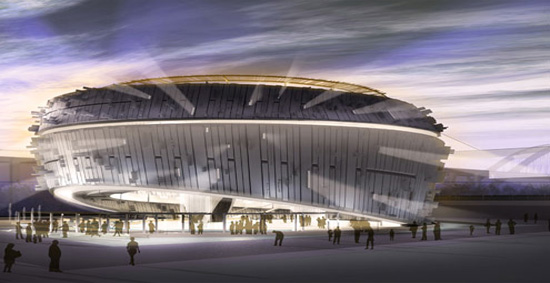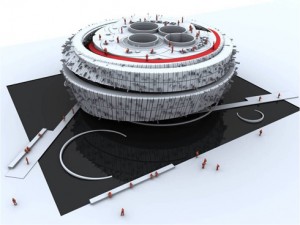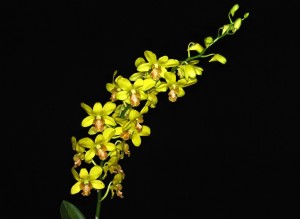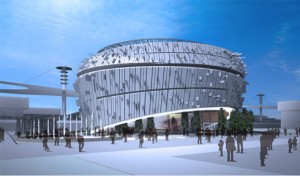Shanghai Expo 2010: The Singapore Pavilion

The 2010 World Exposition in Shanghai will be the first registered one in a developing country. Officially known as “Expo Shanghai 2010,” it will last 184 days and provide China an opportunity to show off its remarkable economic growth. The expo will also give foreign nations and companies a chance to further develop business partnerships with China and Chinese companies. This is the fifth in an ongoing series that will look at the upcoming expo, from country pavilions to trade development. In this article, we take a look at the Singapore Pavilion.
By Emma Xu
SHANGHAI, Aug. 17 – On June 7, the Singapore pavilion, called Urban Symphony, broke ground on an area of 3,000 square meters. The structure, located by the side of Huangpu River, will be viewable from the Lupu Grand Bridge connecting Pudong and Puxi.
The size of the pavilion will mark Singapore’s largest scale participation in any Expo. Designed by Kay Ngee Tan Architects, Urban Symphony resembles a music box through the water fountain movements, sunshade fins on the façade, and interplay of sounds and visuals. The pavilion will showcase the uniqueness of Singapore’s urbanization and sustainability by showing a miniature version of the city-state.
The entire three-story pavilion will be supported by four columns with different shapes and sizes, representing Singapore’s multi-racial society that all share a common goal.
 The ground floor will host image shows, theater performances and various activities. The exhibition continues from the ground floor to a ramp to the second floor with a 600 square meter column-free open space amphitheater that will screen videos about the Singapore’s unique culture. The roof garden with tropical flora on the third floor will allow visitors experience the essence of living in a garden-city.
The ground floor will host image shows, theater performances and various activities. The exhibition continues from the ground floor to a ramp to the second floor with a 600 square meter column-free open space amphitheater that will screen videos about the Singapore’s unique culture. The roof garden with tropical flora on the third floor will allow visitors experience the essence of living in a garden-city.
As a city-state, Singapore has been continuously developing ways to pursue sustainable development. The design of the pavilion is in line with the concept of sustainability. For example, recyclable materials will be used for the façade and the framework of the structure. Running water along the perimeter of the ground floor will be chilled to naturally cool down the structure without wasting a lot of electricity.
 In addition, Singapore has bred a new kind of orchid, named the Singapore Shanghai Expo Dendrobium, to commemorate the event. The Expo is not the country’s first cooperation with China.
In addition, Singapore has bred a new kind of orchid, named the Singapore Shanghai Expo Dendrobium, to commemorate the event. The Expo is not the country’s first cooperation with China.
Bilateral trade has been improving since the two established diplomatic relations in 1990. According to International Enterprise (IE) Singapore, mainland China was Singapore’s third largest trading partner with bilateral trade amounting to SG$91.41 billion in 2008, a more than sixteen-fold increase compared to SG$ 5.3 billion in 1991. Last year, the amount of exports from Singapore to mainland China reached SG$43.8 billion. Mainland China has been Singapore’s fourth largest export destination since 2005.
Agreements such as China’s entry into the World Trade Organization (WTO) in 2001, the signing of China-ASEAN Free Trade Agreement (FTA) in 2005, and the China-Singapore FTA in 2009 have also played important roles in improving bilateral trade.
 China has been Singapore’s top foreign direct investment (FDI) destination since 1997. According to the Chinese embassy in Singapore, the total Singaporean FDI in 2008 amounts to US$4.43 billion, an approximately 40 percent increase over the previous year of US$3.19 billion. By the end of 2008, Singapore launched a total number of 17,372 projects with FDI reaching US$ 37.62 billion.
China has been Singapore’s top foreign direct investment (FDI) destination since 1997. According to the Chinese embassy in Singapore, the total Singaporean FDI in 2008 amounts to US$4.43 billion, an approximately 40 percent increase over the previous year of US$3.19 billion. By the end of 2008, Singapore launched a total number of 17,372 projects with FDI reaching US$ 37.62 billion.
The Expo would bring closer relations between China and the participating countries. We can expect to see Singapore and China further strengthen their bilateral ties.
Further Reading
The complete Shanghai Expo 2010 series
- Previous Article China Remembered: The Silver Russian Samovar at Beijing Capital Airport
- Next Article China Revises Advertising and Promotional Expenses









